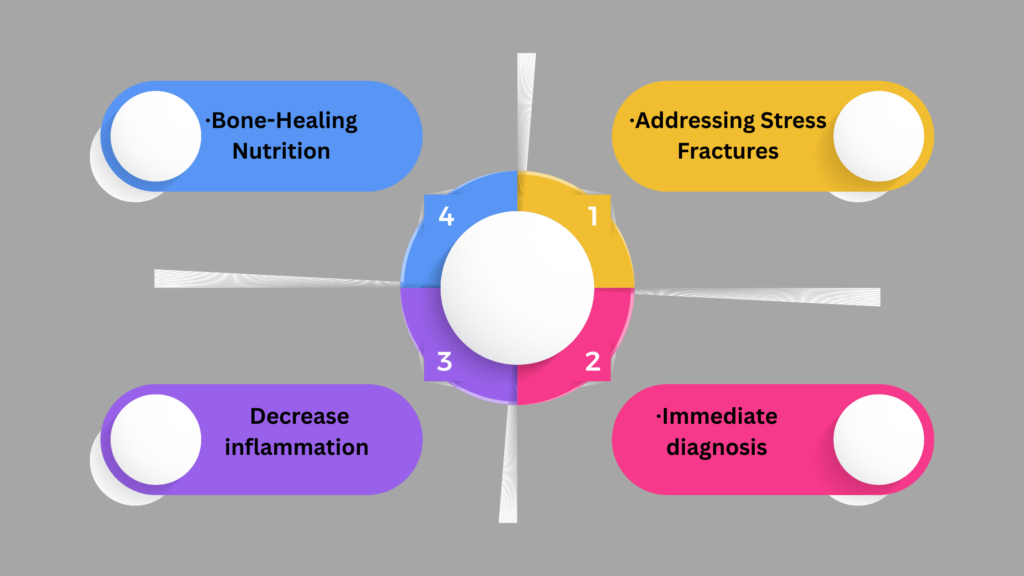
- Addressing Stress Fractures
- Immediate diagnosis
- Focus on Rest and Safety
- Decrease inflammation swelling.
- Bone-Healing Nutrition
- Keeping Hydrated and Limiting Bone-Stalling
- Sleep: Your Defense
- Consider Advanced Therapies
- Slowly Resume Activity
- Consult a physical therapist.
- Prevention of Stress Fractures
Introduction
Stress fractures are microscopic bone cracks generated by persistent strain rather than physical damage. It’s a common ailment among runners and others who abruptly increase their physical activity without proper preparation. These microscopic cracks may appear trivial but can cause long-term issues if not treated appropriately.
The article contains everything about quick stress fracture healing. From early diagnosis to advanced recovery strategies, we’ll show you how to accelerate healing and avoid future setbacks safely.
Addressing Stress Fractures
Most stress fractures occur in weight-bearing bones such as the shinbone, metatarsals, femur, pelvis, and lower back. The discomfort often begins gradually and intensifies with exercise. You may have localized soreness, swelling, and discomfort that subsides during rest but returns when you move. Stress fractures, unlike significant breaks, can be deceptive since the pain isn’t necessarily intense right away.
Ignoring these signals might result in a complete fracture, delayed healing, and even lifelong problems in rare circumstances. That is why early diagnosis and treatment are critical.
Immediate diagnosis
The first and most critical step in fast recovering from a stress fracture is to have an accurate medical diagnosis. Many individuals misdiagnose stress fractures as sprains or muscular strains. A physical examination is frequently followed by imaging procedures such as X-rays or an MRI. An MRI can identify a fracture far earlier than X-rays. The sooner you receive an injury diagnosis, the sooner you may begin a rehabilitation plan tailored to your body and afflicted bone.
Focus on Rest and Safety
Once diagnosed, the next step is to minimize or discontinue the activity that produced the injury quickly. Resting is essential in the healing process. Continuing to apply pressure to the wounded region not only slows healing but also raises the likelihood of a hairline fracture developing into a significant break.
Depending on the location and severity of the stress fracture, your doctor may prescribe a walking boot, crutches, or other supporting devices to keep weight off the injured area. These devices stabilize the bone and speed up healing by decreasing unwanted movement.
Decrease inflammation swelling.
Managing inflammation early after your diagnosis is critical to a speedier recovery. Ice treatment effectively reduces edema within the first 48 to 72 hours. A cold pack for brief minutes daily can alleviate pain and improve recovery. Elevating the injured limb while resting can also assist in relieving swelling and pressure on the injury.
Avoid using anti-inflammatory drugs for an extended length of time without consulting a doctor beforehand. While they might alleviate pain, chronic usage may disrupt the body’s natural healing process.
Bone-Healing Nutrition
Your body needs the appropriate nutrients to heal bone injury. A calcium, vitamin D, magnesium, protein, and vitamin K2 diet speeds bone mending. Calcium is essential for bone development, and vitamin D helps your body absorb it properly. Magnesium and vitamin K2 are also critical for directing calcium to where it is required and building the bone matrix.
Including high-quality protein in your meals promotes tissue regeneration and muscle maintenance during healing. Whole foods such as leafy greens, dairy, almonds, seeds, fatty fish, and legumes should be incorporated into your recovery diet. Sometimes, your doctor may suggest supplements to help you fulfill your daily needs.
Keeping Hydrated and Limiting Bone-Stalling
Water may appear irrelevant, but staying hydrated ensures that your cells operate correctly and that nutrients are delivered to the location of the fracture. On the other hand, certain practices might hinder bone recovery. Excessive coffee and alcohol use can dehydrate your body and limit calcium absorption, weakening your bones over time.
If you smoke, this is the most significant moment to quit. Smoking has been shown to slow bone repair by interfering with oxygen supply and inhibiting the function of bone-forming cells.
Sleep: Your Defense
One of the most underestimated yet effective techniques for speeding up recuperation is obtaining adequate quality sleep. The body heals and restores bone and tissue during sleep. Get seven to nine hours of sleep per night and stick to a schedule. Avoid blue light from phones or devices before bedtime and establish a peaceful environment to promote deep, undisturbed sleep.
If you’re recovering from a significant stress fracture, taking afternoon naps or getting extra rest during the day will help you recover faster.
Consider Advanced Therapies
In addition to standard therapy, some patients benefit from newer, scientifically validated medicines. Cold laser therapy is a non-invasive medicament that uses a specific light wave vector to take the edge off inflammation and enhance bone recovery. Some sports clinics and physical therapists provide this service, and while the outcomes may vary, many athletes claim speedier recovery and less discomfort. Always contact your doctor before attempting alternative therapies, especially if you want to use ultrasound therapy or electromagnetic stimulation for bone repair.
Slowly Resume Activity
One of the most common mistakes people make after suffering a stress fracture is returning to normal activities too quickly. Feeling better does not indicate the bone is completely healed. Re-injury rates are significant among people who disregard the necessity of a gradual comeback.
Your doctor or physical therapist will likely devise a strategy to restore activities gradually. This might start with non-weight-bearing exercises like swimming or cycling, progress to low-impact weight-bearing motions, and finally, complete a return to your old training or lifestyle.
Gradual strength training and flexibility activities will help rebuild the muscles around the broken bone, lowering your chances of suffering another fracture.
Consult a physical therapist.
A skilled rehabilitation plan can help you heal from a stress fracture. A physical therapist will examine your biomechanics, posture, and movement patterns to determine what factors may have led to the fracture in the first place.
They may lead you through exercises to target weak regions and enhance stability. For example, if you suffered a stress fracture in your foot, they may focus on ankle mobility, calf strength, and good foot alignment. Their feedback can also help you gain confidence when you resume regular activities.
Prevention of Stress Fractures
After you’ve healed, your attention should turn to prevention. Overtraining, incorrect footwear, unexpected increases in activity, and poor diet are also significant causes. Cross-training using low-impact activities, following a balanced training program, and listening to your body can all help you avoid injury.
Runners should pay great attention to their footwear. They should replace worn-out shoes regularly and select models that suit their arch type and stride. If they have flat feet or over pronate, orthotic insoles may be useful. Women, in particular, should watch their hormonal health and menstruation cycles since low estrogen levels can damage bones.
Annual bone density testing is also a good idea if you’ve had more than one stress fracture or have risk factors for osteoporosis.
Final thoughts: Healing Fast Requires Smart Strategy.
Healing a stress fracture rapidly is not about pushing through the pain; rather, it is about providing your body with the resources it requires to mend itself swiftly and effectively. Every step, from early diagnosis and rest to proper diet and therapy, adds to a speedier recovery.
Be patient with your body and commit to the process. The combination of science-backed tactics, lifestyle adjustments, and a positive mentality will get you back on your feet quickly and help you remain there for the long term.
